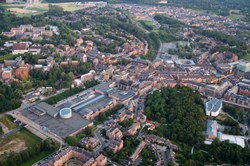A new city
Louvain-la-Neuve is a unique model of a university city in Belgium. Its surprising urban design is inspired by medieval Italian villages with a modern twist.
We owe the idea for the university city design for the most part to Michel Woitrin, the deputy head of the UCL and to Professor Raymond Lemaire, expert in ancient cities. They both wanted a site which respected the landscape, but densely populated and with a mix of urban functions.


You will meet students on every corner as the UCL faculties are everywhere, mingling with the houses and shops. So Louvain-la-Neuve is not a campus, but a real university city. It recreates the atmosphere of a medieval town like Louvain with its maze of streets and passages, its small squares and big public spaces. It encourages contact and dialogue and means there are no long, straight lines. Covered passageways, the limited building height and the warmth of the bricks are additional elements that make up the charm of the city.
There is no single style of architecture in Louvain-la-Neuve! A large number of architects and town planners participated in Louvain-la-Neuve’s construction, to avoid the monotony caused by the uniformity of the site. They were obliged to be innovative given the constraints they were under. As a result, there are buildings with a very individual architectural style which have become strong visual symbols in the city: the University Halls (les Halles Universitaires), Science Square (la place des Sciences), the church of Saint Francis, (l’église Saint-François), the Aula Magna and the Hergé Museum.



 Export agenda
Export agenda
